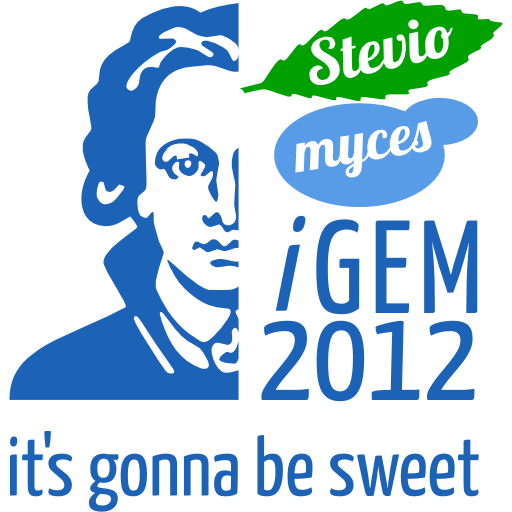Team:Frankfurt/New Yeast RFC
From 2012.igem.org
(→Design of DNA Fragments for Gap-Repair Cloning) |
|||
| Line 21: | Line 21: | ||
==Design of DNA Fragments for Gap-Repair Cloning== | ==Design of DNA Fragments for Gap-Repair Cloning== | ||
The idea of the method is to transform a series of linear, successive DNA Fragments into one yeast cell. The linear fragments have open blunt ends like they occur after a double strand break. If a homologous sequence is avaiable it will be treated like a genomic double strand break and homologous recombination takes place. When the sucessive DNA fragments are designed in a specific way which includes large sequence overlaps to the respectively following fragment yeast will ligate them together. <br> | The idea of the method is to transform a series of linear, successive DNA Fragments into one yeast cell. The linear fragments have open blunt ends like they occur after a double strand break. If a homologous sequence is avaiable it will be treated like a genomic double strand break and homologous recombination takes place. When the sucessive DNA fragments are designed in a specific way which includes large sequence overlaps to the respectively following fragment yeast will ligate them together. <br> | ||
| - | For the formation of a cloning vector (usable in yeast or in other organisms) the first fragmet is a yeast shuttle plasmid which is linearized by an appropiate restriction digest. A shuttle plasmid is a plasmid which is stable both in yeast and in ''Escherichia coli''. The first fragment of the insert has to possess an homologous overlap to both the wished insertion site on the plasmid and to the beginning of the second fragment. The end of the second fragment has to posses an overlap to the beginning of the third one and so on. At least the end of the last fragment of the insert again has to posses an overlap homologous to the second insertion site on the plasmid. | + | For the formation of a cloning vector (usable in yeast or in other organisms) the first fragmet is a yeast shuttle plasmid which is linearized by an appropiate restriction digest. A shuttle plasmid is a plasmid which is stable both in yeast and in ''Escherichia coli''. The first fragment of the insert has to possess an homologous overlap to both the wished insertion site on the plasmid and to the beginning of the second fragment. The end of the second fragment has to posses an overlap to the beginning of the third one and so on. At least the end of the last fragment of the insert again has to posses an overlap homologous to the second insertion site on the plasmid. <br> At the lab of our instructor up to eighteen single fragments were assembled in a single tranformation. Another advantage of the method is that no scars are left between the inserted fragments. Assembly of Fragments to joint Gens is possible. Restriction enzymes only have to be used once for linearization of the shuttle plasmid. |
Revision as of 19:05, 13 September 2012
| Home | Team | Project | Organisms | New Yeast RFC | Notebook | Registered Parts | Modeling | Safety | Attributions | Official Team Profile |
|---|
The Benefit of Vector Assembly in Yeast
Introduction
Gab repair cloning is an elegant method for vector construction. It takes advantage from the homologous recombination system of Sacchaomyces cerevisiae (common yeast) which has a hight activity. What does this means in detail? There are many endogenous and exogenous factors (for example reactive oxygen-species, ionizing radiation, chemicals and failing of DNA binding Enzyms (e.g. collapsed replication forks)) which causes DNA double strand breaks. For the cell this is the most dangerous DNA damage because even if it occurs in rather unimportant regions the cell will not survive the next cell circle. Because of that yeast possesses enzyms which have the ability to repair a broken double strand by pairing it with a very similiar DNA region (typically on the homologous chromosome). This process is called homologous recombination. Using the gap-repair method this natural process can be exploited for the construction of large cloning vectors in yeast.
Design of DNA Fragments for Gap-Repair Cloning
The idea of the method is to transform a series of linear, successive DNA Fragments into one yeast cell. The linear fragments have open blunt ends like they occur after a double strand break. If a homologous sequence is avaiable it will be treated like a genomic double strand break and homologous recombination takes place. When the sucessive DNA fragments are designed in a specific way which includes large sequence overlaps to the respectively following fragment yeast will ligate them together.
For the formation of a cloning vector (usable in yeast or in other organisms) the first fragmet is a yeast shuttle plasmid which is linearized by an appropiate restriction digest. A shuttle plasmid is a plasmid which is stable both in yeast and in Escherichia coli. The first fragment of the insert has to possess an homologous overlap to both the wished insertion site on the plasmid and to the beginning of the second fragment. The end of the second fragment has to posses an overlap to the beginning of the third one and so on. At least the end of the last fragment of the insert again has to posses an overlap homologous to the second insertion site on the plasmid.
At the lab of our instructor up to eighteen single fragments were assembled in a single tranformation. Another advantage of the method is that no scars are left between the inserted fragments. Assembly of Fragments to joint Gens is possible. Restriction enzymes only have to be used once for linearization of the shuttle plasmid.
 "
"
